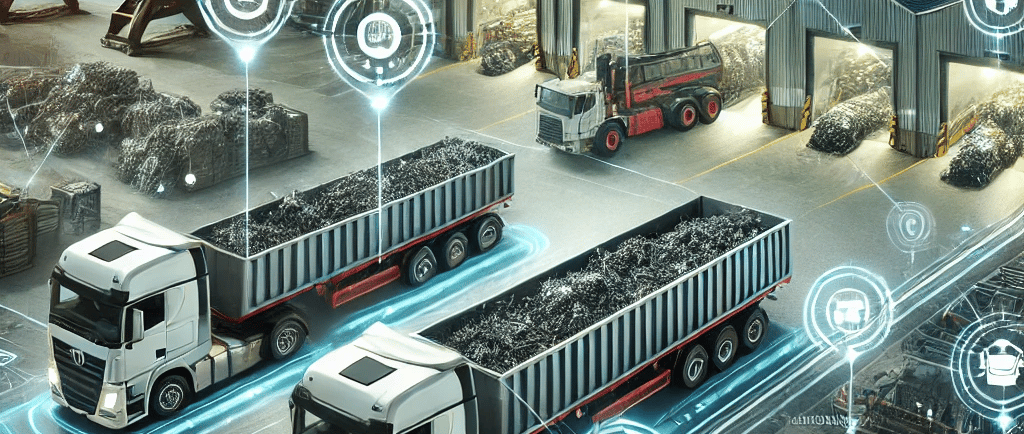How to Optimize Scrap Metal Logistics: A Step-by-Step Guide
Learn how to optimize scrap metal logistics with smart route planning, warehouse management, cost reduction strategies, and emerging technologies like AI, IoT, and blockchain. Improve efficiency, cut costs, and streamline operations for maximum profitability
METALS INDUSTRY ECONOMICS & MARKET TRENDS


Introduction
Scrap metal logistics is a complex process involving transportation, storage, and distribution. Inefficiencies in this system can lead to excessive costs, delivery delays, and operational bottlenecks. However, with proper logistics optimization, businesses can:
✔ Improve efficiency
✔ Cut costs
✔ Enhance operational productivity
✔ Ensure sustainable practices
What You’ll Learn in This Guide:
Key challenges in scrap metal logistics
Best practices for optimizing transportation routes
Warehouse management techniques for scrap metal storage
Cost reduction strategies
Emerging technologies revolutionizing logistics
1. Understanding the Challenges in Scrap Metal Logistics
Before optimizing scrap metal logistics, it’s crucial to identify key challenges that affect transportation and storage.
A. Fluctuating Demand and Supply
The scrap metal industry is highly volatile, with prices shifting based on global demand, raw material availability, and regulatory constraints.
📊 Stat: Scrap metal prices can fluctuate by up to 20% in a single quarter (Bloomberg).
💡 Best Practice: Use AI-driven demand forecasting tools to analyze historical price trends and improve planning accuracy.
B. Heavy Loads and Specialized Handling
Scrap metal requires specialized vehicles and equipment. Mishandling materials can cause:
⚠ Safety hazards
⚠ Compliance violations
⚠ Equipment damage, leading to higher costs
Example: In 2022, a leading metal recycling company in the U.S. reduced handling damage costs by 15% after adopting automated material-handling systems.
C. Route Inefficiencies and High Transportation Costs
Poor route planning results in:
⏳ Longer delivery times
⛽ Higher fuel costs
🚦 Traffic congestion delays
📊 Fact: Traffic congestion costs the trucking industry $75 billion annually in wasted fuel and lost productivity (ATRI).
D. Storage Constraints and Inventory Management
❌ Cluttered warehouses lead to sorting delays and material loss.
✔ Optimized storage solutions improve efficiency and safety.
2. Effective Route Planning for Scrap Metal Transport
A. Use Route Optimization Software
📍 Top Route Optimization Tools:
Route4Me
Google Maps APIs
Verizon Connect
✔ AI-based route predictions reduce delays.
✔ Real-time traffic alerts help drivers avoid congestion.
✔ Dynamic rerouting adjusts for weather, road conditions, and accidents.
💡 Case Study: A European recycling company improved delivery speed by 25% using AI-powered route optimization software.
B. Implement Load Consolidation Strategies
❌ Transporting small, separate loads increases costs.
✔ Batch shipments & combine loads to cut expenses.
💡 Solution: Use digital freight platforms like Convoy or FreightView to consolidate shipments and minimize empty return trips.
C. Track Fleet Performance with Telematics
🚛 Benefits of GPS tracking & telematics:
✔ Monitor driver behaviors (idle times, braking, speeding).
✔ Improve fuel efficiency by reducing unnecessary detours.
✔ Prevent vehicle breakdowns with predictive maintenance alerts.
📉 Impact: Better fleet tracking reduces fuel costs and improves punctuality.
3. Optimizing Warehouse Management for Scrap Metal Storage
📊 Fact: A well-managed warehouse reduces inventory losses by up to 30%.
A. Adopt Smart Storage Solutions
Best Practices:
✔ Vertical storage racks maximize floor space.
✔ Automated sorting systems segregate metals efficiently.
✔ RFID tagging improves inventory tracking.
B. Deploy Warehouse Management Systems (WMS)
A WMS automates inventory tracking, mapping, and order processing.
📊 Impact: Cloud-based WMS boosts warehouse efficiency by 25%.
💡 Example: A Texas-based scrap processing center reduced manual inventory errors by 40% after implementing AI-driven WMS.
C. Strengthen Waste Reduction and Recycling Efforts
Solution: Implement Just-in-Time (JIT) inventory to:
✔ Reduce storage costs
✔ Ensure continuous material flow
✔ Minimize excess waste
4. Cost Reduction Strategies in Scrap Metal Logistics
A. Minimize Fuel Expenditures
⛽ Fuel accounts for 40-50% of transportation costs.
✅ Regular vehicle maintenance boosts fuel efficiency.
✅ Switching to alternative fuels (biofuels, EVs) reduces fuel dependence.
✅ Fuel management software prevents overspending.
B. Automate Documentation and Billing
📜 Benefits:
✔ Blockchain-based record-keeping ensures secure transactions.
✔ Paperless invoicing reduces admin costs by 20% annually.
C. Improve Workforce Productivity
🔹 AI-powered labor scheduling reduces overtime costs.
🔹 Ongoing worker training improves efficiency.
🔹 Incentive programs boost productivity & retention.
5. Leveraging Technology for Logistics Optimization
🚀 Emerging technologies like AI, IoT, blockchain, and robotics are transforming scrap metal logistics.
A. IoT for Real-Time Asset Tracking
IoT-enabled devices enhance logistics by:
✔ Tracking shipments via GPS sensors.
✔ Monitoring metal temperature for optimal storage.
✔ Triggering automated maintenance alerts for trucks.
B. AI for Market Prediction & Logistics Efficiency
✔ Forecasts demand based on historical patterns.
✔ Identifies cost-saving opportunities.
✔ Reduces overstocking risks with smart inventory management.
💡 Example: A Canadian recycling company boosted profit margins by 18% using AI-driven scrap price forecasting.
C. Blockchain for Secure Supply Chain Management
✔ Ensures transparency & traceability in metal transactions.
✔ Prevents fraud by verifying metal origins.
✔ Improves trust in recycling partnerships.
🔹 Bottom Line: Integrating IoT, AI, and blockchain makes scrap metal logistics more transparent, cost-effective, and efficient.
Conclusion: Take Action to Optimize Scrap Metal Logistics
Optimizing scrap metal logistics requires a structured strategy using:
✔ Smart route planning
✔ Advanced warehouse management solutions
✔ Cost-cutting strategies
✔ Technology-driven logistics innovations
Key Takeaways:
✅ Use AI-driven route optimization software to reduce delays.
✅ Implement automated WMS for accurate inventory tracking.
✅ Reduce fuel costs through fleet analytics & predictive maintenance.
✅ Leverage IoT, AI, and blockchain for improved logistics efficiency.
🚀 Looking to streamline scrap metal logistics? Comment below with your biggest challenges or contact a logistics tech provider today!
